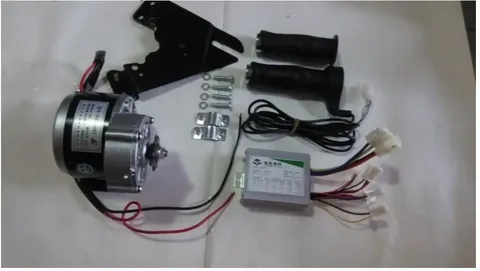Electric Motor for Bicycle | How to Convert, Cost, and Speed
Cycling is one of the best methods of commuting, exercising, or enjoying nature, but it can be more convenient and enjoyable with an electric motor. You may have asked questions such as “When can I add an electric motor to my bike?”, “What is the appropriate size for an electric motor?”, “What is the cost to convert a bike to electric?”, or even “What is the maximum speed for a 1000W electric bike?”. This article will answer all your questions.
Can I Add an Electric Motor to My Bike?
Most bicycles can be transformed into e-bikes by adding electric motors. However, to do this, you should consider your budget, technical proficiency, and performance needs.
Ways to Add Electric Motors to the Bike
Front Hub Motor
This motor is located in the front wheel hub.
– Offers a feeling of being propelled forward.
– Simple installation, but can create traction problems in wet weather conditions.
Rear Hub Motor
This motor is found on the rear wheel where it has better traction.
– Provides more realistic acceleration and control.
– Slightly harder to install than front hub motors.
Mid-Drive Motor
Located at the bike’s crankset.
Powers the chain directly, which increases efficiency.
Best for off-road riding, steep hills, and long distances.
Is more expensive and harder to maintain.
Friction Drive Motor
A motor-driven roller presses against the bike’s rear wheel.
Less effective than the other options, but efficient nonetheless.
Fewer users because of low power transfer.
All types have their advantages, but for the best reliability and performance, a mid-drive or rear hub motor works best.
How Big of an Electric Motor Do I Need for a Bicycle?
Based on how you plan to utilize the bike, its terrain, and rider weight will impact the size of the electric motor needed.
Choosing the Right Motor Size
| Motor Power | Best For | Estimated Speed |
| 250W – 350W | City commuting, flat terrain | 15-20 mph (25-32 km/h) |
| 500W | Moderate hills, longer distances | 20-25 mph (32-40 km/h) |
| 750W | Steeper hills, light off-road | 25-28 mph (40-45 km/h) |
| 1000W | Heavy riders, off-road | 30-35 mph (48-56 km/h) |
| 1500W+ | Extreme terrain, high speed | 40+ mph (64+ km/h) |
Factors to Consider When Choosing a Motor Size
Rider Weight: Performance is best with higher wattage for heavier riders.
Terrain: More torque is needed for hills, as opposed to flat roads which don’t need as much power.
Legal Limitations: Most jurisdictions impose a maximum power limit of 250W or 750W for e-bike motors used on public roads.
Motor Compatibility: High power rated motors are more likely to consume the battery at a faster rate which requires larger capacity batteries.
For everyday commuting, a motor with power output of either 500W or 750W works best. For sustained high-speed riding or steep gradients, anything above 1000W is preferred.
What Is The Cost Of Converting A Traditional Bicycle Into An Electric Bicycle?
The estimated cost of converting a traditional bicycle into an electric bicycle highly depends on the particular motor being used, battery, and other optional extra features.
| Component | Cost Range |
| Hub Motor Kit (Front/Rear) | $250 – $800 |
| Mid-Drive Motor Kit | $500 – $1,500 |
| Battery (Lithium-ion 36V – 52V) | $300 – $1,000 |
| Controller & Wiring | $50 – $200 |
| Display & Throttle | $40 – $150 |
| Installation (if not DIY) | $100 – $300 |
| Total Estimated Cost | $500 – $2,500 |
Motor Type: Mid-drive motors are more expensive than hub motors.
Battery Capacity: higher voltage (e.g., 52V) and higher amp-hour(Ah) capacity increases cost.
Brand & Quality: Higher price, but better trusted brands like Bafang, Bosch, and Shimano. REPUTABLE brands.
DIY vs Professional Installation: A professional installation increases the overall cost but ensures the system is made operational.
An average conversion will set you back $500 to $1,000, with pricier configurations exceeding $2500.
How Fast Does a 1000W Electric Bike Go?
Compared to lower-wattage models, a 1000W Electric bike has substantially more speed. Nonetheless, speed varies according to battery voltage, rider’s weight, terrain, and bike aerodynamics.
Other Considerations Other factors that influence the speed performance of a 1000W E-Bike include:
Battery Voltage: A 48V battery will provide moderate speed, while a 52V battery is likely to increase the top speed.
Bike Weight: Bikes that are heavier such as those made with thick tires have more rolling resistance.
Rider & Cargo Weight: Lower top speed for bikes is achievable the more weight is added.
Wind Resistance: Being in headwinds or riding in an upright posture also reduces speed.
Legal Considerations
The following regions currently limit the use of 100W E-bikes:
UK & EU: Restricted to 250W on public roads.
USA: Some states consider 750W as the limit for Class 3 E-bikes but <1000W is often off-road use only.
Australia: Ranges from 200 to 750W depending on the state.
Always confirm your local guidelines before riding a 1000W electric bike on public roads.
Conclusion
The performance of a bicycle can be noticeably improved by installing an electric motor, as it facilitates faster and less strenuous rides. If you need a 250W motor for city commuting, or a 1000W+ motor for adventure and speed, the right setup always depends on your riding style, terrain, and budget. While the cost of a full conversion ranges from $500-2,500, the investment will provide a personalized e-bike experience uniquely crafted to your requirements.




Post Comment